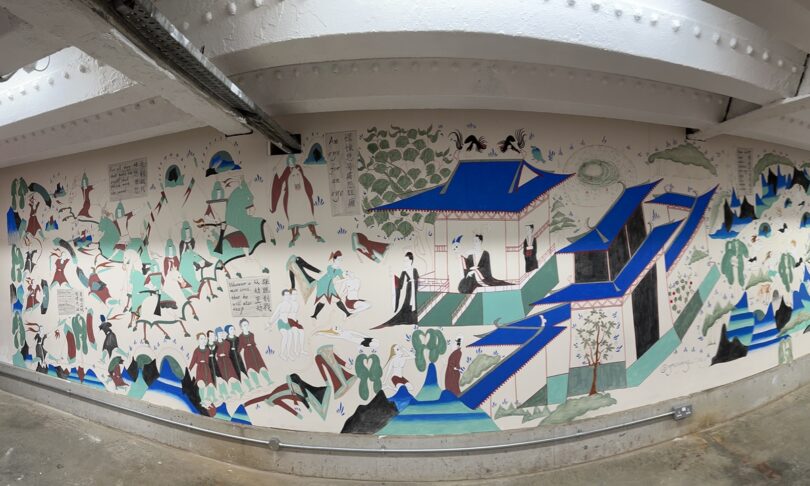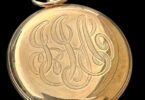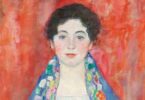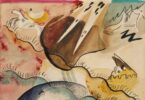Hou Xiangjun
BEIJING : “I believe that art has the power to change and influence things and hopefully my work does too,” up-and-coming Chinese artist Cong Yunfeng told the Global Times recently. His mural works, Conversion of the Five Hundred Bandits, received a strong response to the controversial blockbuster exhibition, China’s Hidden Century, which is ongoing at the British Museum until October 8.
Collecting stolen relics from many countries has cast a shadow over the British Museum, especially the exhibition of China’s Hidden Century, billed as something that “Chinese people can’t laugh after visiting it” by netizens. The controversy started with the display of cultural relics from Qing Dynasty (1644-1911) that were looted from China by hostile foreign armies.
The hashtag related to the exhibition reached more than 6.3 million views by October 7 on Chinese social media platform Sina Weibo. Meanwhile, it racked up 13.2 million views as of October 7 on short video platform Xiaohongshu.
“What a shame!” “It is heartbreaking to see these magnificent relics lost overseas, which obviously belong to the Chinese. When can they be returned to China?” were among the comments and questions written by netizens.
According to the official website of the British Museum, the exquisite and beautiful objects were being brought together for the first time, from cloisonné vases given by the court of Puyi, the last emperor of the Qing Dynasty, to King George and Queen Mary for their coronation in 1911, to a silk robe commissioned by the Empress Dowager Cixi. The show highlights the lives of individuals: an empress, a dancer, a soldier, an artist, a housewife, a merchant and a diplomat.
Even the original of “Treaty of Nanjing” is on display.
One of the most discussed items by Chinese netizens was an exclusive to the British Museum – the Portrait of Lady Li from 1876 for the official promotional image, showing the strangest appearance with pallid eyes that went viral online.
“This portrait reflects Western stereotypes and stunted aesthetics of China,” noted one comment on Xiaohongshu.
‘Mixed feelings’
Cong’s artworks come amid the controversy of China’s Hidden Century exhibition. “When I visited the British Museum years ago, I always had mixed feelings as I saw a lot of artifacts from China in the crowded display, and this exhibition finally triggered long suppressed emotions,” he told the Global Times.
His feelings spurred thinking, engagement and action.
He transformed modifications based on the original imagery, the Dunhuang mural Conversion of the Five Hundred Bandits, dating back to the Western Wei Dynasty (535-556).
The original mural vividly depicted scenes of suppression, capture, interrogation, eye-gouging, exile and restoration of sight.
As an artist, he shows an eclectic taste in painting, introducing metaphorical elements through the replacement of the facial features of the bandits with those of the characters from Italian Renaissance painter Michelangelo’s The Last Judgment.
Moreover, the work was divided into six parts, with the headline description taken from Buddhist scriptures and Western classical works and integrated into the artwork. Like the first part head, “Violence is the midwife of everyone old society pregnant with a new one,” was taken from Das Kapital.
Cong said that this exhibition presented a historical period marked by colonialism. Reflecting on history, he embarked on a period of contemplation to respond to the post-colonial era with the “Wall-facing Project.”
“The ‘Wall-facing Project’ reflects the current state of multiculturalism in the context of globalization advocating for a cultural decentralization experiment,” Cong said.
Through presenting cultural symbols from different civilizations in the form of murals and graffiti in public spaces within the framework of the Western contemporary visual system, he creates effects of convergence, collision and conflict among diverse cultures, reflecting on the impact of Western-led globalization on multiculturalism.
‘Genes of all mankind’
It seems like most kids like to draw on the walls, true to form, Cong’s first brushstroke was painted on a wall too.
“This could be all mankind’s childhood memory,” Cong told the Global Times. He described this action as “genes of all mankind.”
Cong became interested in painting when he was a 2-year-old toddler, and now “it’s his life,” he added.
Born in 1990, he graduated from Central Academy of Fine Arts, majored in mural painting since 2013, and also studied at the Prince’s Foundation School of Traditional Arts, the UK from 2014 to 2016.
Cong has always had a passion for murals, he stressed that the wall, as a carrier, is also alive and can be brought to life by interacting with people.
Another piece of works, Playing Pipa behind the Back, at London’s Leake Street Graffiti Tunnel was taken from the image of playing pipa – a pear-shaped stringed traditional Chinese musical instruments – behind the back in a mural painting from the middle Tang Dynasty (618-907) at Dunhuang’s Mogao Grottoes.







